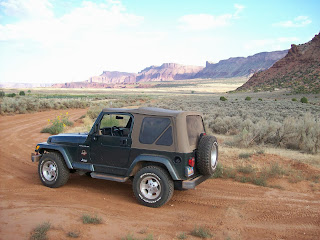The day after Thanksgiving Day in November of 2010 my son
Rob and I hiked to Druid Arch in Canyonlands Nat’l Park for the first time.
Since the early 2000’s we had been all around that area by Jeep, but we had
never made the hike to Druid Arch.
Late November 2010 was very cold, but the weather was clear
and sunny during the day. There was snow on the ground and all water sources
were solid ice from the Elephant Hill Trail Head to Druid Arch.
Upon returning to Druid Arch in November 2013, we found a
different set of circumstances, but we loved the contrasting weather. This time
there was still snow on the ground, but it was warmer than the 2010 experience.
What was so different this time in addition to the temperature difference, we
now had low clouds and fog.
We love doing the hike to Druid Arch in the winter because
we’re unsure of any consistent water sources and with an 11 mile round trip (10.8
miles) hike, you could end up carrying a lot of water if you hiked in warmer
temperatures. This time there was plenty
of pools of water in Elephant Canyon to filter. But because of the cool temps,
we each used less than 2 liters per person and didn’t need any extra water
beyond what we started out with.
The trail to Druid Arch is well signed and easy to follow.
There are four different trail junctions on the way to Druid Arch. The only
potential trouble is on the way back from the arch the junction that takes you
out of Elephant Canyon can be easily missed and take you to EC 1 camp instead.
We like to start from the Elephant Hill Trail Head because
it is the shortest distance unless you drive over Elephant Hill back to the
Joint Trail. Even then you only cut off 4 tenths of a mile each way.
From the trailhead you work your way up to the next rock
formation level, and you’ll stay at that level for a while, with some minor ups
and downs. The first two miles of the
hike take you through a couple of sections of high rock formations by
short-cutting through some narrow sections.
At the 1.5 mile mark you’ll reach the first junction in the
trail. A turn east would take you back to the Squaw Flats Campground. We turn west and head in the direction of
Chesler Park .
We pass through another narrow section and head down a steep
section and in to Elephant Canyon. On your way down look across the canyon to
the north and you can see a nice sized hiker’s camp. That is EC1.
Once you reach Elephant Canyon you are at the next junction.
You can keep going west if you want to go to Chelser Park. But to get to Druid
Arch you will stay in this canyon from now on.
Most of the way is along the canyon floor, but occasionally
you’ll need to follow the trail up and around obstacles. We found that
following the trails up was always a good choice. The only exception would be
the spur trails to the camps, EC 2 and EC 3.
Side canyons appear on occasion but it’s easy to stay in the
main canyon and find your way.
Periodically another junction will be reached, but just stay
in Elephant Canyon and keep going.
At one point, if you know what you are looking at you can
see Druid Arch from its north facing side view. That means in just a few bends
you’ll climb out of the canyon to your left and start working your way up to
the level of the base of the arch.
Eventually you’ll use a permanently attached ladder and
metal pole to cross a big boulder. This can be tricky if there is snow
accumulation as it’s sheltered from the sun in the winter time and metal bar
can be very slippery when wet.
Then it’s up a rock fall to an awesome view of Druid Arch.
With the low clouds and fog made for some really nice photos
of the arch and views down Elephant Canyon.
If you go left at the top of the rock fall instead of the
popular access point to the right, you can get some nice shots of the arch from
a distance that is further away.
We like to stop for lunch and rest awhile near the arch. But
we make sure we get back on the trail with enough time for the return trip as
the daylight is short in the wintertime. Not being a huge hurry, we took about
2.5 hours to hike to the arch, and about 2 hours to hike back, with a stop of
about an hour at the arch.
Back Country Camping: Camps EC2 and EC3 are found in
Elephant Canyon and are very nice backpacking camps. EC2 is a bit of climb up
while EC3 is not too far from the streambed.























